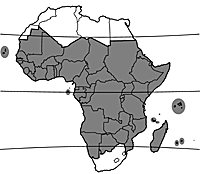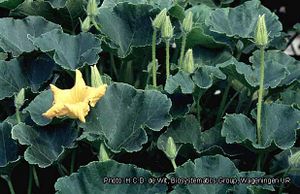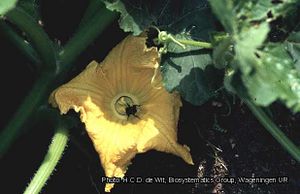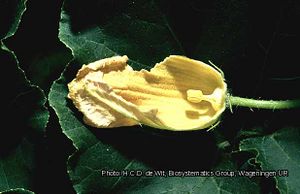Cucurbita maxima (PROTA)
Introduction |
| General importance | |
| Geographic coverage Africa | |
| Geographic coverage World | |
| Fruit | |
| Vegetable | |
| Medicinal | |
| Timber | |
| Ornamental | |
| Food security | |
Cucurbita maxima Duchesne
- Protologue: Essai Hist. Nat. Courges: 7, 12 (1786).
- Family: Cucurbitaceae
- Chromosome number: 2n = 40
Vernacular names
- Pumpkin, winter squash (En).
- Potiron, courge d’hiver, courge turban (Fr).
- Abóbora-menina, abóbora-moranga (Po).
- Mtango (Sw).
Origin and geographic distribution
Cucurbita maxima originates from temperate South America. Cucurbita andreana Naudin is considered the wild progenitor; this species is native to warmer temperate zones in South America as well as humid lowland regions of Bolivia. Seeds of Cucurbita maxima excavated in Peru have been dated at 1800 BC. After 1492, when Columbus arrived in the Americas, it spread all over the tropics and subtropics, as well as temperate areas with warm summers. Cucurbita maxima has been reported from many countries in tropical Africa and probably occurs in all countries. It is most important in the cooler parts of southern Africa and the Sahel region, less important in more humid West and East Africa, where Cucurbita moschata Duchesne is more common.
Uses
The mature fruits, leaves, flowers and seeds of Cucurbita maxima are used as vegetables. Most crops are grown for the fruits, but the leaves are locally important too. The leaves are regarded as a bit coarse and of lesser quality than those of Cucurbita moschata, although this disappears in cooking. They are used fresh and in some locations dried for use during the off-season. The mature fruit is peeled, cut into pieces and cooked until soft. In Zimbabwe it is made into a popular porridge. In Cameroon, Nigeria and other western African countries, seeds are commonly roasted and salted, or ground into a thick paste that is mixed with vegetables in cooking. They are exported to the Middle East where they are a popular snack. The seed is rich in oil, which is sometimes extracted for kitchen use. The big, yellow-orange fruits of certain cultivars are used for decoration. Dried fruit-shells can be used for making bowls.
In North America, great healing qualities for skin problems such as sores and ulcers are attributed to pumpkin seed oil. Traditionally, American Indians use the seeds to treat intestinal infections and kidney problems and to expel tapeworms; the flowers are used topically to soothe minor injuries. In southern Europe the seeds are also used as an anthelmintic. In India, a paste of the fruit stalks is used to heal boils and earache.
Production and international trade
World production of pumpkin and squash (all Cucurbita species taken together) in 2001 was estimated at 16.4 million t from 1.2 million ha, and production in Africa at 1.8 million t from 140,000 ha. China and India are the largest producers with nearly 4 million t each, followed by Ukraine (900,000 t) and Egypt (360,000 t). In tropical Africa, a production of 205,000 t has been recorded for Rwanda, 120,000 t for Cameroon and 70,000 t for Sudan. The international demand for pumpkin seeds, especially from Cucurbita maxima, is significant but official statistics are not available. This demand is mainly from Arab countries, where roasted seeds are a popular snack, but recently also from Western countries, where the seed oil is now in demand for the pharmaceutical and cosmetics industry. At national level, the leaves, fruits and often also seeds are found on local markets.
Properties
The composition of pumpkin fruits per 100 g edible portion (67% of purchased, flesh only, seeds removed, peeled thickly) is: water 95.0 g, energy 55 kJ (13 kcal), protein 0.7 g, fat 0.2 g, carbohydrate 2.2 g, fibre 1.0 g, Ca 29 mg, P 19 mg, Fe 0.4 mg, β-carotene 450 μg, thiamin 0.16 mg, riboflavin trace, niacin 0.1 mg, folate 10 μg, ascorbic acid 14 mg (Holland, B., Unwin, I.D. & Buss, D.H., 1991).
The composition of pumpkin leaves per 100 g is: water 89.2 g, energy 113 kJ (27 kcal), protein 4.0 g, fat 0.2 g, carbohydrate 4.4 g, fibre 2.4 g, Ca 477 mg, P 136 mg, Fe 0.8 mg, β-carotene 3600 μg, thiamin 0.06 mg, riboflavin 0.32 mg, ascorbic acid 80 mg. The composition of pumpkin seeds (without shell) per 100 g is given as: water 5.5 g, energy 2331 kJ (555 kcal), protein 23.4 g, fat 46.2 g, carbohydrate 21.5 g, fibre 2.2 g, Ca 57 mg, P 900 mg, Fe 2.8 mg, thiamin 0.15 mg, niacin 1.4 mg (Leung, W.-T.W., Busson, F. & Jardin, C., 1968). Pumpkin seeds also contain considerable amounts of vitamin E.
All cucurbits contain triterpene glycosides called cucurbitacins. These compounds are present in all plant parts in different concentrations. If concentrated in the edible parts, they cause a bitter taste. In Cucurbita maxima they are present in small amounts only, unlike Cucurbita andreana, which may contain considerable amounts. The antigenotoxic compound spinasterol was isolated from Cucurbita maxima flowers. In in-vivo tests with mice it decreased the mutagenicity of tetracycline by 65% at a dosage of 100 mg/kg. Crude ethanolic extracts of seeds showed strong antimalarial activity, reducing by 50% the levels of parasitaemia in Plasmodium berghei-infected mice at an oral dosage of 500 mg/kg. Seeds and vascular exudates of Cucurbita maxima contain proteinase inhibitors that prevent proteolytic activity of trypsin or chymotrypsin. One of these proteins, Cucurbita maxima trypsin inhibitor V (CMTI-V), is also a specific inhibitor of human blood coagulation factor XIIa.
Adulterations and substitutes
The fruits, leaves and seeds of Cucurbita moschata can be used as a substitute for Cucurbita maxima. Egusi (Citrullus lanatus (Thunb.) Matsum. & Nakai and Cucumeropsis mannii Naudin) are substitutes for pumpkin seeds.
Description
- Annual, scandent herb, climbing by lateral, 2–5-branched tendrils, strongly branched; stems rounded, long running, softly pubescent, often rooting at nodes.
- Leaves alternate, simple, without stipules; petiole (5–)10–20 cm long; blade usually reniform, not lobed to shallowly 5–7-lobed, 7–25(–30) cm in diameter, deeply cordate at base, margins finely toothed, softly hairy, occasionally with white blotches, 3-veined from the base.
- Flowers solitary, unisexual, regular, 5-merous, large, 10–20 cm in diameter, lemon yellow to orange-yellow; sepals free, subulate to linear, 0.5–2 cm long; corolla campanulate, with widely spreading lobes; male flowers long-pedicelled (up to 23 cm), with 3 stamens, filaments free, anthers connivent into a long twisted body; female flowers shortly pedicelled (up to 5.5 cm), with inferior, ellipsoid, 1-celled ovary, style thick, stigmas 3–5, 2-lobed.
- Fruit a large, globose to ovoid or obovoid berry, weighing up to 50 kg, with a wide range of colours; flesh yellow-orange, many-seeded; fruit stalk cylindrical, not enlarged at apex. Seeds obovoid, flattened, 1.5–2.5 cm × 1–1.5 cm, white to pale brown, surface smooth to somewhat rough, margin prominent.
- Seedling with epigeal germination; hypocotyl 3–3.5 cm long; cotyledons elliptical, 2.5–4 cm long, cuneate at base, obtuse at apex, entire.
Other botanical information
It is often not easy to distinguish Cucurbita maxima plants or fruits from the related Cucurbita moschata and Cucurbita pepo L. The plant habit is similar and the fruit shape and size are variable. Distinction is easiest by observing differences of the fruit stalk, stems and leaves. Cucurbita maxima has a soft, rounded fruit stalk not enlarged at the apex, soft, rounded stems and soft, usually unlobed leaves. Cucurbita moschata has a hard, smoothly angled fruit stalk widened at the apex, hard, smoothly grooved stems and soft, moderately lobed leaves. Cucurbita pepo has an angular fruit stalk sometimes slightly widened at the apex, hard, angular, grooved, prickly stems and palmately lobed, often deeply cut and prickly leaves.
Cucurbita andreana, a species related to Cucurbita maxima and sometimes considered a subspecies of the latter, occurs wild in Argentina and Bolivia; it hybridizes readily with Cucurbita maxima. It may be the ancestor of Cucurbita maxima.
There are numerous cultivars of Cucurbita maxima in Western countries. A classification into cultivar-groups has been proposed, but it is of little relevance for tropical Africa. Some well known cultivars imported in East and sSouthern Africa are ‘Turban’, ‘Mammoth’ and ‘Flat Boer’.
Growth and development
Seed germinates 5–7 days after sowing. The plants form an extensive fibrous root system. The growth habit is indeterminate; under suitable conditions, the trailing stems continue to grow indefinitely when they are permitted to root at the nodes. The stems may reach a length of more than 20 m, but they are usually no longer than about 5 m. Bushy cultivars with short internodes and semi-erect stems also exist. Flowering starts 35–60 days after germination and is more or less continuous. The ratio of male to female flowers is about 20:1. This ratio is influenced by the growing conditions, long days and high temperatures favouring male sex expression. Production of the sticky pollen is abundant. Anthesis and pollination take place early in the morning. Insects, mainly bees, effect pollination, so the flowers are predominantly cross-pollinated. The fruits mature 30–40 days after pollination. One or two fruits develop per stem. The fruit-harvesting period extends from 2–6 months after sowing.
Ecology
Cucurbita maxima pumpkins are grown in the tropics from the lowlands up to 2000 m altitude. Optimum mean daily temperatures for growth are 18–27°C. Cucurbita maxima is more tolerant to low temperatures than Cucurbita moschata, but less tolerant to high temperatures. It is almost insensitive to photoperiod and tolerates some shading. Cucurbita maxima is rather drought tolerant, requiring relatively little water, and is sensitive to frost and waterlogging. Pumpkins can be produced year round in frost-free areas, although excessive humidity during the rainy season stimulates the development of fungal and bacterial diseases causing leaf decay, wilting and fruit rot. Pumpkins are not very demanding with respect to soil. They can be cultivated on almost any well-drained soil with a neutral or slightly acid reaction (pH 5.5–6.8). They will grow on reasonably fertile soil, but do best on soils rich in organic matter.
Propagation and planting
Cucurbita maxima is grown from seed. As it roots at the nodes it can be grown from cuttings, but this is only done for research purposes. Seed of improved, mostly imported, cultivars is rarely used in tropical Africa, where most farmers produce their own seed. It is important to take only top quality fruits from healthy plants for this purpose. For seed extraction, mature fruits are split and fermented, then the seed is collected, washed, cleaned and dried. Farmers sow in small hills on flat land or in raised beds, 2–4 seeds per hill. Seeds can be sown in containers and the seedlings transplanted into the field when they are about 10 cm tall, but direct seeding is generally practised in most African countries.
Pumpkin is often grown in home gardens. It grows well on organic matter and is often encountered on refuse heaps, on termite hills and on fertile patches in the field and around homesteads. In urban areas, it is planted in backyard gardens mixed with maize; in the field, it is usually intercropped with cereals such as maize and sorghum, or with groundnut. Sole cropping is common for commercial production, e.g. when grown for the seeds. A common planting distance is 2 m × 2 m, giving a plant population of 2500 plants/ha. The 1000-seed weight is about 200 g; the seed requirement is 2–3 kg/ha. Many farmers use much more seed, up to 7 kg/ha. Because of the branching and creeping plant habit, the optimal planting density is flexible, varying from 600–4000 plants/ha; the number of plants per hill is 1–4. With a dense planting, the soil will be covered and weeds will be suppressed more quickly.
Management
The crop responds well to farm manure and to side dressings of liquid manure. Depending on soil fertility, the following application is recommended: 50–100 kg/ha N, 20–40 kg/ha P and 40–80 kg/ha K during the vegetative phase. Some of the minerals can be applied as a top dressing of NPK 10–10–10, e.g. 50 kg/ha or 20 g per plant at the first fruit setting. Irrigation should be applied under dry conditions, e.g. weekly 50 mm.
Diseases and pests
Many diseases and pests attack Cucurbita maxima; they are the same as for Cucurbita moschata, but are possibly more serious under humid conditions. Only the most serious ones will be mentioned here. Downy mildew (Pseudoperonospora cubensis) often becomes a devastating disease under conditions of high air humidity. It starts on the older leaves with pale green angular spots, bounded by leaf veins. The lower surface becomes covered with a faint, purplish layer and the entire leaf dies. Control is by wide spacing, good drainage and aeration and by crop rotation. Powdery mildew (Erysiphe cichoracearum) may be severe under low humidity. The upper side of affected leaves is covered with white powdery fungus growth; the leaves become yellowish and dry out. Alternaria leaf spot or leaf blight (Alternaria cucumerina) is a fungal disease that defoliates and kills the plants within weeks. This fungus also causes fruit rot. The symptoms, small round whitish necrotic spots, later with concentric circles, appear on the oldest leaves; the leaves turn grey or yellow and dry out. The use of healthy seed, removal of plant debris and crop rotation may provide some control. Gummy stem blight or gummy canker (Didymella bryoniae, anamorph: Phoma cucurbitarum) is a serious cause of crop losses everywhere. First the nodes with nearly ripe fruits are attacked; they become oily-green and sap exudes forming drops of gum, while the stems beyond the affected area wilt. This fungus also causes seedling death, fruit stalk canker and fruit rot. Control is by using healthy seed and protective fungicides, e.g. mancozeb, and by crop rotation. No cultivar resistance has been reported. Fusarium wilt (Fusarium oxysporum) causes yellowing of the leaves followed by wilting of stems or the whole plant. It can be controlled by using healthy seed, removing debris, crop rotation and avoiding excessive nitrogen fertilization. Anthracnose (Colletotrichum lagenarium) is a destructive disease worldwide. It causes defoliation and lesions on the fruits. All diseases mentioned may be seedborne; it is therefore important to use only seeds from healthy plants. Other diseases are scab (Cladosporium cucumerinum), causing small spots on all plant parts, and Choanephora wet rot (Choanephora cucurbitarum), causing fruit rot. Of the many viruses reported on Cucurbita maxima the most important ones are cucumber mosaic virus (CMV), papaya ring spot virus (PRSV-W), squash leaf curl virus (SLCV), watermelon mosaic virus (WMV-2) and zucchini yellow mosaic virus (ZYMV). These viruses often occur in combination. They are spread by mechanical infection and insects (mainly aphids, whitefly and thrips), and probably some by seed.
Insect pests are seldom serious. Nevertheless it is important to keep aphids, whitefly and thrips under control to avoid spreading virus diseases. Whitefly (e.g. Bemisia spp.) may cause damage. Leaf-feeding Epilachna beetles may be harmful on young plants. A ladybird (Henosepilachna elaterii) is reported as a major pest on pumpkins in Sudan. Spider mites (Tetranychus spp.) may also cause damage.
Harvesting
Pumpkin fruits are picked when nearly or fully mature, 4–6 weeks after flowering, and are harvested in several rounds until the crop stops producing, 90–120 days after planting. Some African farmers leave the fruits in the field until they collect the whole crop. For leaf consumption, usually the third and fourth leaves from the tip are harvested; the first and second leaf are left to continue growing. Sometimes the tips are removed to promote branching. Occasionally flowers and young immature fruits are harvested for consumption.
Yield
The yield largely depends on cultivar and growing conditions. The number of mature fruits harvested per plant is low, and the weight of individual fruits, mainly depending on cultivar, varies widely from 1–50 kg. Under extensive low input management, the yield is low, around 5 t/ha. With good care, a yield of 15 t/ha is reasonable, and with improved cultivars a yield of 30 t/ha is possible. Excessive picking of the young leaves and shoots reduces fruit yield. Seed yield is variable, possibly 300–500 kg/ha. If grown for seed, isolation between fields of different Cucurbita species is recommended, not only for reasons of purity but also to obtain maximum yields, because pollen of other species may cause reduced fruit set or parthenocarpic fruits.
Handling after harvest
Leaves are consumed fresh or in dried form. Before cooking the main veins of the leaves are removed. For drying, the leaves are cut into small pieces and spread in the open to dry for 1–2 days depending on weather conditions. The leaves are stored in containers. Healthy fruits can be stored for several months on slatted shelves with good ventilation. The flesh can be dried in strips for later use in soups and stews. Seeds are often extracted as the fruits are consumed; some are stored for future planting, others are used as food. When a crop is grown for its seed the fruit is a by-product. Seeds are offered either in their shell or after shelling, shelled seeds commanding considerably higher prices. The shelling process is tedious when done by hand; mechanized shelling is now carried out in several countries, e.g. Nigeria and Sudan. Care should be taken not to break the seeds and not to remove the shell too long before sale at the market. Shelled seeds are more likely to be affected by storage pathogens, especially Aspergillus species, which release poisonous aflatoxins under warm, humid conditions.
Genetic resources
Cucurbita species are well represented in the cucurbit germplasm collections of many institutions all over the world. However, little attention has been paid to germplasm of African types. The National Seed Storage Laboratory (NSSL), Fort Collins, Colorado, United States, and the Vavilov Institute of Plant Industry (VIR), Petersburg, Russia maintain important base collections. With the introduction of improved cultivars, ancient landraces are in danger of disappearing and collection of germplasm of African landraces deserves priority.
Breeding
Cucurbita maxima is cross-pollinated but self-compatible, inbreeding causing little loss of vigour. A considerable degree of heterosis of inbred lines has been observed. Hand pollination of the large flowers is easy. Seed companies are less interested in open-pollinated cultivars, because farmers can easily produce their own seed. Western seed companies have commercialized many F1-hybrids. A Japanese seed company has developed ‘Shintoza’, an interspecific hybrid of Cucurbita maxima and Cucurbita moschata, which combines high vigour and resistances to soilborne diseases and nematodes. It is used as rootstock for cucumber instead of chemical soil disinfection. Breeding work in the tropics is rare and little breeding work has been reported from tropical Africa.
Prospects
As a multipurpose vegetable Cucurbita maxima makes a valuable contribution to the food resources of Africa. Yield levels can be increased considerably as cultural practices are extensive and as almost no breeding for yield, disease or pest resistance and quality has been done. Besides development of improved cultivars for the fruits, attention should be paid to the potential of the leaves and seed. Hybrid cultivars with virus resistance genes have considerable potential.
Major references
- Bates, D.M., Robinson, R.W. & Jeffrey, C. (Editors), 1990. Biology and utilization of the Cucurbitaceae. Cornell University Press, New York, United States. 485 pp.
- Blancard, D., Lecoq, H. & Pitrat, M., 1994. A colour atlas of cucurbit diseases: observation, identification and control. Manson Publishing, London, United Kingdom. 299 pp.
- Esquinas-Alcazar, J.T. & Gulick, P.J., 1983. Genetic resources of Cucurbitaceae. IBPGR, Rome, Italy. 101 pp.
- Guha, J. & Sen, S.P., 1998. Physiology, biochemistry and medicinal importance. In: Nayar, N.M. & More, T.A. (Editors). Cucurbits. Science Publishers Inc., Enfield NH, United States. pp. 97–127.
- Holland, B., Unwin, I.D. & Buss, D.H., 1991. Vegetables, herbs and spices. The fifth supplement to McCance & Widdowson’s The Composition of Foods. 4th Edition. Royal Society of Chemistry, Cambridge, United Kingdom. 163 pp.
- Leung, W.-T.W., Busson, F. & Jardin, C., 1968. Food composition table for use in Africa. FAO, Rome, Italy. 306 pp.
- Messiaen, C.-M., Blancard, D., Rouxel, F. & Lafon, R., 1991. Les maladies des plantes maraîchères. 3rd Edition. INRA, Paris, France. 552 pp.
- Robinson, R.W. & Decker-Walters, D.S., 1997. Cucurbits. CAB International, Wallingford, United Kingdom. 226 pp.
- Sharma, B.R. & Tarsem Lal, 1998. Improvement and cultivation: Cucurbita and Benincasa. In: Nayar, N.M. & More, T.A. (Editors). Cucurbits. Science Publishers Inc., Enfield NH, United States. pp. 155–168.
- Widjaja, E.A. & Sukprakarn, S., 1993. Cucurbita L. In: Siemonsma, J.S. & Kasem Piluek (Editors). Plant Resources of South-East Asia No 8. Vegetables. Pudoc Scientific Publishers, Wageningen, Netherlands. pp. 160–165.
Other references
- Burkill, H.M., 1985. The useful plants of West Tropical Africa. 2nd Edition. Volume 1, Families A–D. Royal Botanic Gardens, Kew, Richmond, United Kingdom. 960 pp.
- Chigumira Ngwerume, F., 2000. Survey of literature on mandate vegetable species of the SADC Plant Genetic Resources Centre, Lusaka Zambia, occurring in Zimbabwe. Regional Vegetable Crop Working Group Report, May 2000. pp. 98–99.
- Chigumira Ngwerume, F. & Mvere, B., 1999. The status of traditional leafy vegetables in Zimbabwe. In: Chweya, J.A. & Eyzaguire (Editors). The biodiversity of traditional leafy vegetables. IPGRI, Rome, Italy. pp. 155–171.
- FAO, 1999. FAO Production Yearbook 1998. FAO, Rome, Italy.
- Messiaen, C.-M., 1989. Le potager tropical. 2nd Edition. Presses Universitaires de France, Paris, France. 580 pp.
- Paris, H.S., 2000. First two publications by Duchesne of Cucurbita moschata (Cucurbitaceae). Taxon 49: 305–319.
- Purseglove, J.W., 1968. Tropical Crops. Dicotyledons. Longman, London, United Kingdom. 719 pp.
- Sanjur, O.I., Piperno, D.R., Andres, T.C. & Wessel-Beaver, L., 2002. Phylogenetic relationships among domesticated and wild species of Cucurbita (Cucurbitaceae) inferred from a mitochondrial gene: Implications for crop plant evolution and areas of origin. Proceedings of the National Academy of Sciences of the United States of America 99(1): 535–540.
- Sherf, A.F. & MacNab, A.A., 1986. Vegetable diseases and their control. 2nd Edition. John Wiley & Sons, New York, United States. 728 pp.
- Stevels, J.M.C., 1990. Légumes traditionnels du Cameroun: une étude agrobotanique. Wageningen Agricultural University Papers 90–1. Wageningen Agricultural University, Wageningen, Netherlands. 262 pp.
- Tindall, H.D., 1983. Vegetables in the tropics. Macmillan Press, London, United Kingdom. 533 pp.
- van Epenhuijsen, C.W., 1974. Growing native vegetables in Nigeria. FAO, Rome, Italy. 113 pp.
- Villasenor, I.M., Lemon, P., Palileo, A. & Bremner, J.B., 1996. Antigenotoxic spinasterol from Cucurbita maxima flowers. Mutation Research 360(2): 89–93.
- Whitaker, T.W. & Davis, G.N., 1962. Cucurbits - botany, cultivation and utilization. Leonard Hill, London, United Kingdom. 249 pp.
Sources of illustration
- Stevels, J.M.C., 1990. Légumes traditionnels du Cameroun: une étude agrobotanique. Wageningen Agricultural University Papers 90–1. Wageningen Agricultural University, Wageningen, Netherlands. 262 pp.
Author(s)
- F. Chigumira Ngwerume, Horticultural Research Centre, P.O. Box 810, Marondera, Zimbabwe
- G.J.H. Grubben, Boeckweijdt Consult, Prins Hendriklaan 24, 1401 AT Bussum, Netherlands
Correct citation of this article
Chigumira Ngwerume, F. & Grubben, G.J.H., 2004. Cucurbita maxima Duchesne. [Internet] Record from PROTA4U. Grubben, G.J.H. & Denton, O.A. (Editors). PROTA (Plant Resources of Tropical Africa / Ressources végétales de l’Afrique tropicale), Wageningen, Netherlands.
Accessed 17 December 2024.







